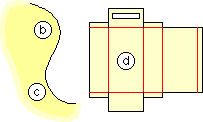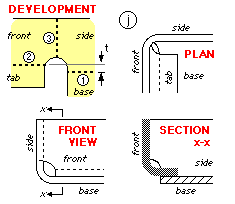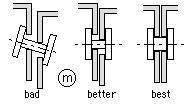Common shortcomings in letterbox designs

The following shortcomings are common in beginners' designs - most of these but not all apply to the design of the letterbox with curved roof shown above.
- overall shape is time-consuming to mark out and cut due to awkward geometry (b)
- overall shape cannot be cut on a guillotine because of concavity and/or re-entrants (c,d)

- shape is wasteful of material - there is substantial scrap (d)
- shape of box makes for inefficient packaging, stacking, transporting etc, or prevents drainage
- box calls for accurate (read expensive) fits (e)
- blind slits cannot be effected without distortion (though holes at their ends would help, at added expense) and cannot be cut neatly by a guillotine (d)
- a rectangular slot (d) cannot be cut cleanly unless pressed out, which is too sophisticated here

- adjacent bends (f) need special formers to be carried out
- perpendicular bends such as the tabs (g) need a magnetic bender or other special treatment
- bends >90o (h) require specialised production
- a triple bend at a corner might be OK with thin card but
 leads to unsightly distortion in metal unless special pains are taken to offset the parallel bend lines before bending (j) (refer the dimension tin the development) - the bending sequence 1-2-3 also needs expensive care
leads to unsightly distortion in metal unless special pains are taken to offset the parallel bend lines before bending (j) (refer the dimension tin the development) - the bending sequence 1-2-3 also needs expensive care
- missing tabs for welding (d), though present in (j)
- tab ends must be chamfered
- tabs around curved joint would need to be bent manually one by one
- bending tabs would distort front panel adjacent to slot - tabs are too close to slot
- spot welding each blind tab is laborious as a welder cannot see it from outside the box - and imagine what would happen if you asked a welder to spotweld an essentially closed box !
- tabs on outside are unsightly; tabs must not be too narrow for the loads carried
- welds on visible panels are visible also
- overlapped metal at a joint traps moisture and is a potential site for accelerated rusting

- riveted joints are dearer than spot welds - the pieces must first be aligned, clamped and drilled (how?)
- curved panels cannot be bent consistently without special formers or time-consuming rolling
- large expanses of unsupported / unstiffened panels are liable to bend / damage easily (k)
- insufficient support of panels in way of door will lead to binding of door when it's operated

- pivots / hinges are not specified completely and may wear quickly if unsuitable (galvanic corrosion?)
- lack of sufficient metal around holes makes ligaments susceptible to damage (if cardboard model is easily damaged then the metal protoype is also susceptible)
-
 pivot location prevents full opening of components (l) (cardboard model may squidge to allow opening, but metal won't)
pivot location prevents full opening of components (l) (cardboard model may squidge to allow opening, but metal won't)
- a hinge pin which is too long leads to a sloppy connection (m)
- a rivet is unsuitable for a hinge - how to relieve its tight grip on assembly?
- sliding doors are less suitable than hinged doors - slides are prone to binding and corrosion (slides are traps for blown sand which quickly destroys any protective film - plating or painting)
 a door without a stop (n) can lead to excessive loads being put on hinge
a door without a stop (n) can lead to excessive loads being put on hinge
- six mounting screw holes are unnecessary; one is insufficient to prevent rotation (o)
 necessary mounting holes missing or too close together for box stability (large leverage leads to distortion), or insufficient metal between them
necessary mounting holes missing or too close together for box stability (large leverage leads to distortion), or insufficient metal between them
- because of integral roof it is impossible to wield a normal screwdriver to mount assembled box - a bad design fault, this!
- a non-horizontal base cannot be mounted on a horizontal surface without an additional bracket or spacer
- lack of lip over letter slot makes letter insertion unnecessary hard (think of detailed insertion process);is also less weatherproof
- space in box wasted since letter slot is less than full width
- opening at small end of box makes access more difficult than it need be
- no provision for padlock, deemed necessary by some users
- metal thickness not specified.
Most of these faults arise from either not knowing or not visualising the step-by-step operations carried out by other people - in this case particularly sheet metal workers measuring, cutting out, bending, spotwelding and so on. The owner's and postman's wishes should have been foreseen.
"OK," you say, "So there are all these shortcomings - it's all rather negative, listing the things I shouldn't do. But what should I do? How can you possibly have a letterbox which avoids all these traps?"
Well, how about this for simplicity?
 Copyright 1999-2005 Douglas Wright
Copyright 1999-2005 Douglas Wright
last updated May 2005


 leads to unsightly distortion in metal unless special pains are taken to offset the parallel bend lines before bending (j) (refer the dimension tin the development) - the bending sequence 1-2-3 also needs expensive care
leads to unsightly distortion in metal unless special pains are taken to offset the parallel bend lines before bending (j) (refer the dimension tin the development) - the bending sequence 1-2-3 also needs expensive care


 pivot location prevents full opening of components (l) (cardboard model may squidge to allow opening, but metal won't)
pivot location prevents full opening of components (l) (cardboard model may squidge to allow opening, but metal won't)
 a door without a stop (n) can lead to excessive loads being put on hinge
a door without a stop (n) can lead to excessive loads being put on hinge
 necessary mounting holes missing or too close together for box stability (large leverage leads to distortion), or insufficient metal between them
necessary mounting holes missing or too close together for box stability (large leverage leads to distortion), or insufficient metal between them
